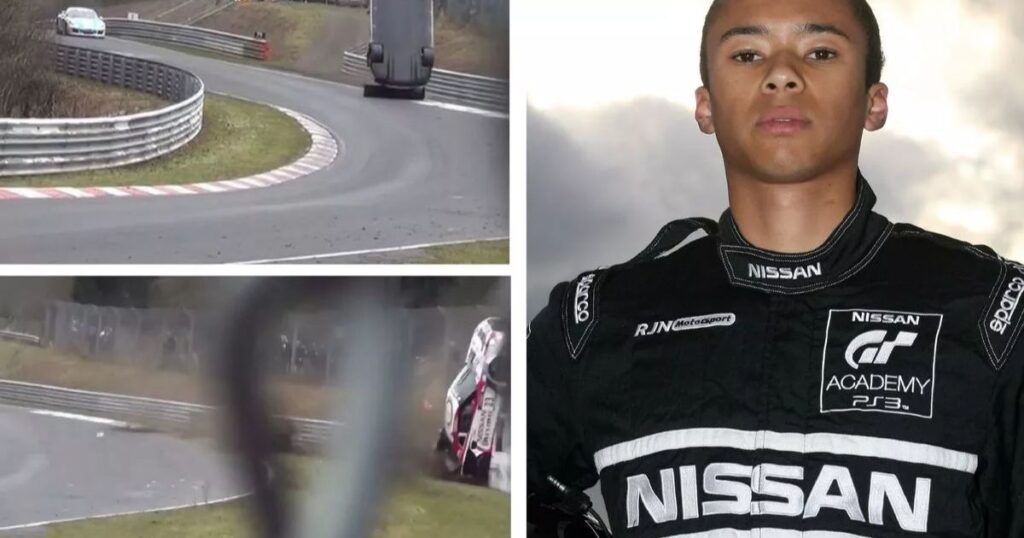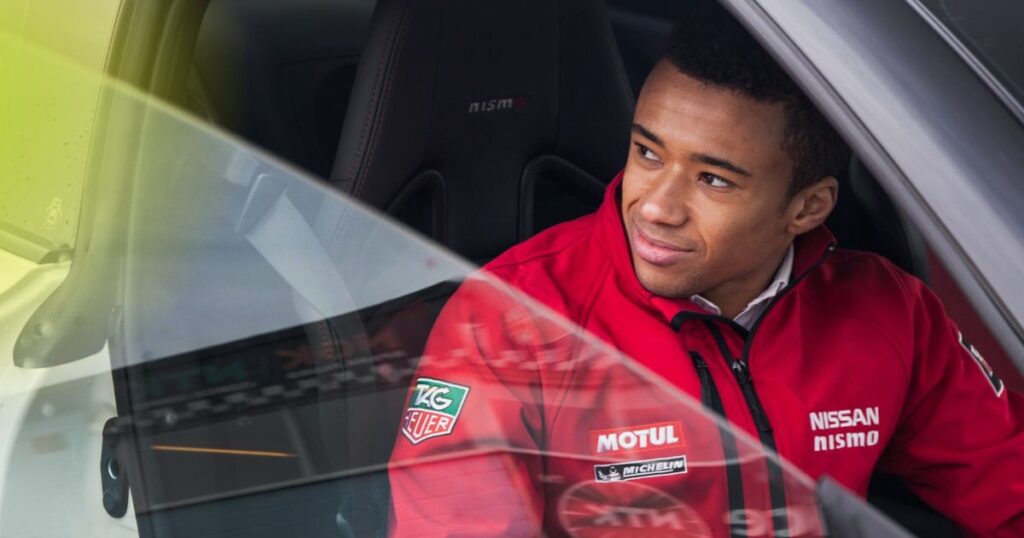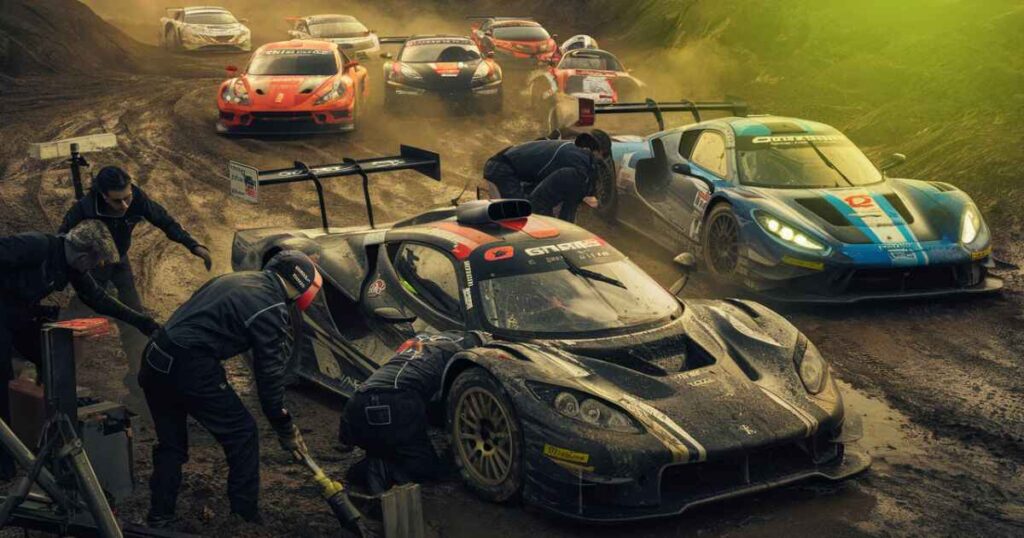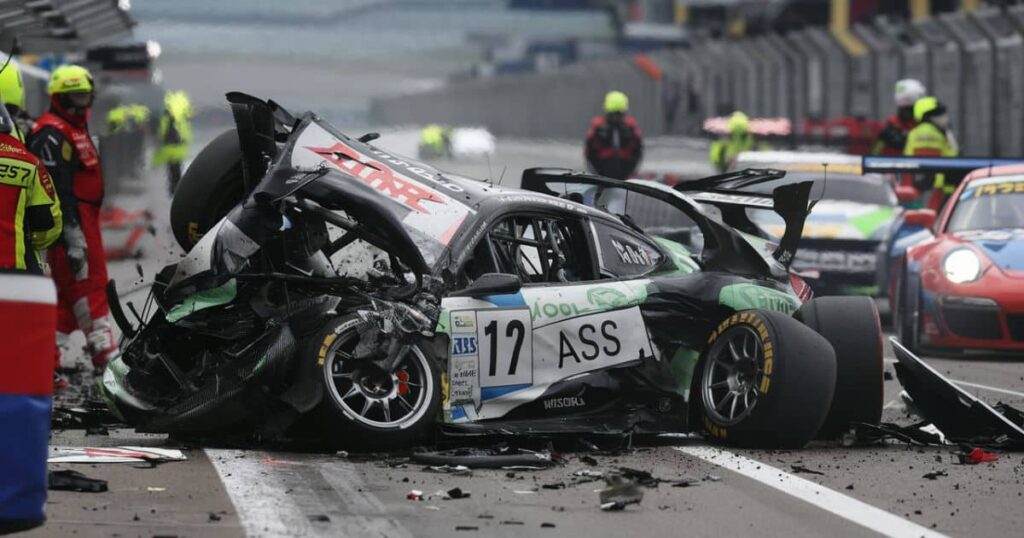In the high-octane world of motorsport, few stories captivate the imagination quite like that of Jann Mardenborough. His extraordinary journey from video game enthusiast to professional race car driver is a testament to the evolving landscape of talent acquisition in racing.
Mardenborough’s meteoric rise was tragically marred by a horrific accident at the Nürburgring in 2015, an event that would not only reshape his career but also spark intense debates about safety in motorsport.
This article delves deep into Mardenborough’s remarkable path, the tragic incident that shook the racing world, and its far-reaching consequences.
Jann Mardenborough’s Meteoric Rise from Gamer to Racer

Jann Mardenborough’s story begins not on the sun-baked tarmac of a racetrack, but in the dim glow of a television screen. The GT Academy, a revolutionary competition that aimed to transform skilled gamers into real-world racers, provided Mardenborough with an unprecedented opportunity to turn his virtual passion into a high-speed reality.
Born in Darlington, England, in 1991, Mardenborough grew up with a controller in his hands and racing in his heart. His exceptional skills in the virtual realm of Gran Turismo didn’t just earn him high scores – they caught the discerning eyes of talent scouts looking for the next generation of racing drivers.
Mardenborough’s transition from digital to physical racetracks was nothing short of remarkable. His journey included:
- Winning the 2011 GT Academy competition
- Intensive physical and mental training to prepare for real racing
- Obtaining his international racing license in record time
- Debuting in professional racing just months after his GT Academy victory
His natural talent, honed through countless hours of gaming, translated surprisingly well to actual racing. The precision, focus, and split-second decision-making skills developed in the virtual world proved invaluable on real circuits.
“I never imagined that playing video games could lead to a career in motorsport. It’s been an incredible journey, filled with challenges and triumphs I couldn’t have dreamed of,” Mardenborough once remarked in an interview.
Early successes came swiftly, with podium finishes in various championships, proving that his virtual skills had tangible, real-world applications. Mardenborough’s rapid ascent in the racing world was punctuated by a stunning achievement that silenced any remaining doubters: a third-place finish at Le Mans in 2013, just two years into his professional career.
Le Mans Success: A Gamer’s Triumph
Mardenborough’s podium finish at the prestigious 24 Hours of Le Mans in 2013 was more than just a personal victory – it was a validation of the entire GT Academy concept. Competing in the LMP2 class, Mardenborough, along with his teammates, showcased remarkable endurance, skill, and racing acumen.
This accomplishment:
- Proved that gamers could compete at the highest levels of motorsport
- Opened doors for more non-traditional paths into professional racing
- Inspired a new generation of young racing enthusiasts
- Demonstrated the transferability of skills from virtual to real racing
Mardenborough’s success at Le Mans cemented his status as a rising star in motorsport and seemed to herald a bright future filled with more victories and accolades.
The Horrific 2015 Nürburgring Accident
On March 28, 2015, during a VLN Endurance Championship race at the Nürburgring, Mardenborough’s promising career took a tragic and unforeseen turn. Driving a Nissan GT-R NISMO GT3, he experienced what would become one of the most horrific accidents in recent motorsport history, a moment that would forever change his life and career trajectory.
The incident unfolded at the notoriously dangerous Flugplatz section of the track, a part of the circuit known for its challenging topography and high-speed characteristics. Mardenborough’s car suddenly became airborne, a terrifying sight that spectators and fellow racers watched in horror.
The sequence of events happened in mere seconds:
- The GT-R hit a bump at high speed, causing it to lift off the ground
- Aerodynamic forces further lifted the car, sending it vertical
- The vehicle cleared the safety fence, which was several meters high
- It somersaulted through the air, landing in a spectator area
- Emergency services immediately halted the race and rushed to the scene
The crash resulted in the death of one spectator and left several others injured, casting a dark shadow over the event and the sport as a whole.
Eyewitness accounts described a scene of chaos and disbelief. One spectator, Hans Mueller, recounted:
“It was like watching a movie in slow motion. The car just kept climbing higher and higher. We couldn’t believe our eyes when it cleared the fence. Then came the horrible realization of where it was going to land.”
The racing community was shocked. The Nürburgring, long known for its challenging nature and nicknamed “The Green Hell” by Formula One driver Jackie Stewart, had once again demonstrated why it’s considered one of the most dangerous tracks in the world.
Survivor’s Remorse: Mardenborough’s Internal Struggle
The psychological impact of the accident on Mardenborough was profound and long-lasting. Surviving such a catastrophic event, especially one that resulted in a fatality, left deep emotional scars that would take years to heal.
Mardenborough grappled with:
- Survivor’s guilt
- Post-traumatic stress
- The weight of responsibility, despite later being cleared of fault
- Doubts about continuing his racing career
His recovery process involved not just physical healing but extensive psychological support. Sports psychologists worked closely with Mardenborough to help him process the trauma and rebuild his confidence.
The racing community rallied around him, offering support and understanding. Fellow drivers who had experienced similar incidents reached out, sharing their experiences and coping strategies. This support network played a crucial role in Mardenborough’s eventual return to racing.
Dr. Sarah Thompson, a sports psychologist who works with racing drivers, explains the unique challenges faced by athletes in these situations:
“In high-risk sports like racing, athletes must confront not just the physical dangers but also the psychological toll of accidents, especially those involving fatalities. The process of overcoming such trauma is complex and deeply personal.”
Mardenborough’s resilience in the face of this tragedy would become a defining aspect of his character and career, inspiring many with his determination to continue pursuing his passion despite the enormous emotional burden.
Jann Mardenborough’s Crash & What Happened In Real Life

A detailed analysis of the accident revealed a complex interplay of factors that contributed to the tragic outcome. Understanding these elements is crucial not only for preventing future incidents but also for appreciating the inherent risks in motorsport.
Key factors in the crash included:
- Aerodynamic lift: The car’s design, combined with the track’s contours, created unexpected lift. At high speeds, even small aerodynamic imbalances can have catastrophic consequences.
- Speed: The high velocities achieved at this section of the track contributed to the car’s instability. The Flugplatz section is known for its high-speed approach, making it particularly dangerous.
- Track characteristics: The Flugplatz section’s unique profile played a role in the car becoming airborne. A slight crest in the track, combined with the car’s speed and aerodynamics, created the perfect conditions for lift-off.
- Weather conditions: While not a primary factor, the clear, dry conditions allowed for maximum speed, potentially exacerbating the aerodynamic issues.
- Mechanical factors: Investigations ruled out any mechanical failure, emphasizing the role of aerodynamics and track design in the incident.
Experts compared this incident to other historical accidents in motorsport, noting similarities and differences:
| Accident | Year | Similarities | Differences |
| Mercedes-Benz at Le Mans | 1955 | Car became airborne, spectators affected | Higher fatality count, led to Mercedes withdrawal from racing |
| Mark Webber at Le Mans | 1999 | GT car flipped due to aerodynamic issues | No spectator injuries, occurred during practice |
| Peter Dumbreck at Le Mans | 1999 | Similar aerodynamic lift issues | Occurred multiple times with same model, led to withdrawal |
The Mardenborough crash stood out due to its spectacular nature, the involvement of spectators, and the unique context of Mardenborough’s background as a gamer-turned-racer.
Dr. Elena Rodriguez, an aerospace engineer specializing in racing aerodynamics, offers insight:
“The Nürburgring incident highlights the delicate balance in race car design. We’re constantly pushing the limits of performance, but events like this remind us of the paramount importance of safety. It’s a wake-up call for continuous improvement in both car and track design.”
This accident not only changed Mardenborough’s life but also had far-reaching implications for motorsport safety regulations and car design philosophy.
Mardenborough Perseveres: Comeback and Continued Career
Despite the trauma of the Nürburgring accident, Jann Mardenborough’s passion for racing remained undiminished. His return to the track was a testament to his determination and mental fortitude, inspiring many in the motorsport community and beyond.
The comeback wasn’t without its challenges:
- Rebuilding confidence behind the wheel
- Coping with media scrutiny and public attention
- Adapting to new safety measures implemented post-accident
- Overcoming flashbacks and anxiety during races
Mardenborough worked closely with a team of professionals, including sports psychologists and performance coaches, to prepare for his return. His first few races back were emotionally charged affairs, with every lap serving as a personal victory over fear and doubt.
“Getting back in the car was one of the hardest things I’ve ever done,” Mardenborough shared in a post-comeback interview. “But it was also necessary. Racing is part of who I am, and I couldn’t let fear take that away.”
His performances post-accident showed flashes of his earlier promise, though the incident undoubtedly impacted his career trajectory. Notable achievements after his return included:
- Competing in the Japanese Super GT series
- Participating in the FIA World Endurance Championship
- Serving as a development driver for various racing teams
While the accident may have altered the course of his career, Mardenborough’s continued presence in high-level motorsport stands as a testament to his resilience and skill.
More Post:
If I File Bankruptcy, What Happens To My Car?
Safety Overhaul in Motorsport’s Dangerous Realm

The Nürburgring accident prompted a comprehensive review of safety measures in motorsport, leading to significant changes across various racing series and tracks worldwide.
Changes implemented included:
| Area of Improvement | Specific Measures |
| Track Safety | Enhanced barriers and catch fencing, redesigned run-off areas |
| Car Design | Improved aerodynamic stability regulations, enhanced cockpit protection |
| Spectator Areas | Redesigned viewing zones with increased protection, stricter access control |
| Emergency Response | Updated protocols for rapid intervention, improved on-site medical facilities |
| Driver Training | Enhanced safety courses, including specific training for aerodynamic incidents |
These changes rippled through the motorsport world, influencing safety standards far beyond the Nürburgring. Other notable improvements included:
- Advanced simulation and testing procedures for new car designs
- Increased use of data analysis to predict and prevent potential safety issues
- Regular safety audits of tracks and racing facilities
- Enhanced communication systems between drivers, teams, and race control
FIA Safety Director, Dr. Marcus Weber, commented on the broader impact:
“Every incident, especially those as serious as the Nürburgring accident, pushes us to innovate and improve. The changes implemented in the wake of this event have made motorsport safer not just in Germany, but around the world.”
The motorsport community’s ability to learn from tragedies and implement sweeping changes demonstrates its commitment to protecting drivers, spectators, and the sport’s future.
Gran Turismo’s Jann Mardenborough Crash Scene Controversy Explained
The release of the “Gran Turismo” movie in 2023 brought Mardenborough’s story to a wider audience, introducing his remarkable journey from gamer to racer to millions of viewers worldwide. However, the decision to include a recreation of the Nürburgring crash sparked significant controversy and debate within both the racing and film communities.
Why Gran Turismo’s Crash Scene Is Controversial
The inclusion of the crash scene raised several ethical questions and concerns:
- Sensitivity to victims: How to portray a tragedy that resulted in real-life loss without exploiting the pain of those affected
- Accuracy vs. dramatization: Balancing historical facts with cinematic storytelling requirements
- Impact on Mardenborough: Concerns about reopening old wounds and the potential psychological effect on the driver
- Public perception: Risk of sensationalizing a tragic event for entertainment purposes
- Educational value: Debating whether including the scene could serve as a powerful reminder of motorsport risks
Film critic Laura Chen argues:
“While the crash is undeniably a pivotal moment in Mardenborough’s story, its inclusion walks a fine line between honoring the reality of motorsport dangers and potentially traumatizing viewers or those involved in the actual event.”
The “Gran Turismo” Movie’s Controversial Depiction
The film’s portrayal of the accident differed from reality in several key ways:
- Altered timeline of events to fit the movie’s narrative structure
- Dramatized emotional responses of characters for cinematic effect
- Simplified explanation of crash causes, potentially misrepresenting the complex factors involved
- Enhanced visual effects that may have exaggerated the spectacle of the accident
These changes, while potentially enhancing the narrative flow and emotional impact of the film, sparked debates about the responsibility of filmmakers when depicting real-life tragedies.
Director Sam Harris defended the decision:
“Our goal was to honor Jann’s incredible journey while also highlighting the very real dangers that exist in motorsport. We consulted closely with Jann and safety experts to ensure we struck the right balance between accuracy and storytelling.”
The controversy surrounding the crash scene in “Gran Turismo” opens up broader discussions about the ethics of portraying real-life tragedies in cinema and the impact such portrayals can have on public understanding of historical events.
Final Words
Jann Mardenborough’s journey from gamer to racer, marred by the horrific Nürburgring accident, embodies both the dreams and dangers inherent in motorsport. His story is a compelling narrative of triumph over adversity, illustrating the potential for unconventional paths to success in racing while also highlighting the ever-present risks that drivers face.
The accident’s impact extended far beyond Mardenborough’s personal career, influencing safety standards across motorsport and sparking important discussions about the portrayal of real-life tragedies in media. It serves as a sobering reminder of the fine line between excitement and danger that defines high-speed racing.
As we reflect on this extraordinary tale, we’re reminded of the resilience of the human spirit, the importance of continuous improvement in safety measures, and the ongoing challenge of balancing the thrill of motorsport with the paramount concern of protecting all involved.
Mardenborough’s continued involvement in racing, despite the trauma he experienced, stands as a testament to his passion and determination. His story continues to inspire a new generation of racers, whether they begin their journey on a console or a kart track.
The controversy surrounding the film adaptation of his story further underscores the complex relationship between real-life events and their portrayal in popular media, challenging us to consider how we remember and represent significant moments in sports history.
As motorsport evolves, incorporating new technologies and attracting talent from diverse backgrounds, the lessons learned from Mardenborough’s experience will undoubtedly play a crucial role in shaping a safer, more inclusive future for the sport.
What are your thoughts on motorsport safety? How do you feel about the portrayal of real-life tragedies in films? Share your opinions in the comments below.
Frequently Ask Questions
Was the accident in Gran Turismo real?
Yes, the accident depicted in Gran Turismo is based on a real incident involving Jann Mardenborough at the Nürburgring in 2015.
Did Jann Mardenborough really win Le Mans?
Jann Mardenborough didn’t win Le Mans but achieved a notable third-place finish in his class in 2013.
Why did Jann Mardenborough stop racing?
Jann Mardenborough has not stopped racing; he continues his career despite the 2015 Nürburgring accident.
How many drivers have died on the Nürburgring?
Over 200 drivers have died on the Nürburgring since its opening, making it one of the most dangerous tracks in the world.
Who was the F1 driver killed at the Nürburgring?
F1 driver Niki Lauda had a near-fatal crash at the Nürburgring in 1976, but he survived; no F1 drivers have died at the track.







